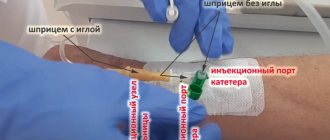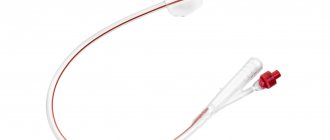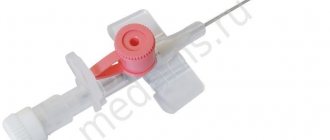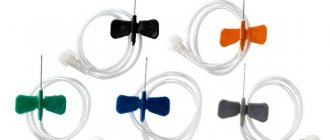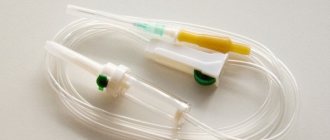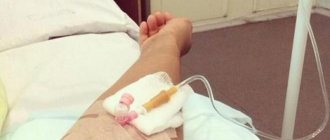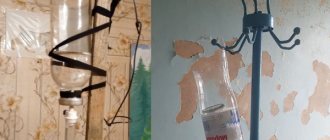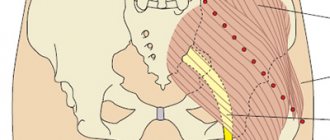Description
The central catheter is a long, thin tube that is inserted into a large vein. A central catheter is used to deliver medications, nutrition, intravenous drugs, and chemotherapy into the bloodstream.
There are different types of central catheters, including:
- Peripheral central catheter - the catheter is inserted through a vein in the arm until it reaches a vein close to the heart;
- A non-tunneled central venous catheter is inserted into a large vein in the neck or leg; the end of the tube is outside the skin.
- A tunneled catheter is a catheter that is secured in place when scar tissue forms. It can be used for several weeks or months. The catheter is inserted into a large vein in the neck, which returns blood to the heart. It is then advanced along the chest wall and removed through the skin at a distance of about 12 cm from the injection site into the vein.
- Port catheter - a device inserted into a vein in the shoulder or neck. A port (titanium chamber) is placed under the skin and a catheter is inserted into a central vein. To administer medications, the port membrane is pierced with a special needle, and for the next 3-5-7 days, any solutions in any quantities can be injected through this needle.
Peripherally implanted central venous catheter (PICC)
A peripherally implantable central venous catheter (PICC) is a minimally invasive device for providing long-term central venous access.
Purpose:
The PIC catheter is intended for short-term or long-term peripheral access to the central venous system for intravenous therapy, administration of contrast agents and allows monitoring of central venous pressure.
Description:
The catheter is implanted in a peripheral vein in the arm and passed to the central (superior vena cava or subclavian) vein. The location of the catheter is on the inner surface of the shoulder. The catheter is used during chemotherapy, long-term drip administration of drugs, long-term parenteral nutrition and frequent blood transfusions. The use of a PIR catheter reduces the risk of complications and provides the possibility of outpatient treatment of patients. Catheter.
Depending on the modification, the PICC catheter consists of one or two tubes up to 60 cm long, made of bioinert polyurethane.
Advantages of the PIC catheter compared to other long-term central venous access devices:
- Increased safety of PIC catheter placement compared to port or tunneled catheter placement.
- Minimal blood loss during PIC catheter placement.
- A single puncture of the vein when installing a PIC catheter and no additional injections throughout the entire course of treatment.
- No need to use special needles (as for ports).
- The universal Luer connector at the end of the catheter makes it easy to connect the infusion system.
- Safe and easy removal of the PIC catheter without surgery or incisions - simply pull on the outside of the catheter to remove it.
- Minimal visibility - the catheter is hidden under clothing (under the sleeve).
OKPD2 - 32.50.13.110: Syringes, needles, catheters, cannulas and similar instruments
Item code KTRU - 32.50.13.110-00005222 : Peripherally inserted central venous catheter
Description of CTRU: A sterile, thin, flexible tube designed to be inserted into a peripheral vein and advanced into a central vein to provide short-term or long-term intravascular access for the administration of medications (antibiotics), chemotherapy agents, nutrients, parenteral solutions, anesthetic fluids, and sometimes for specimen collection. blood, blood pressure and temperature monitoring, and contrast injections; The product is not intended primarily for extracorporeal hemotherapy such as hemodialysis. The device, also known as a peripherally inserted central catheter, typically includes special accessories for insertion/operation of the catheter (eg, Luer connectors, stylet). This is a single use product.
Set contents:
- Central venous catheter.
- Tissue expander (dilator).
- 5 ml syringe (with needle).
- Scalpel.
- Injection caps.
- Holder (catheter clamp).
- Roller clamp.
go to product page
| Shelf life: 5 years | Sterilized by OE |
Sterile, pyrogen-free, non-toxic
Individual packaging: blister . Group packaging: cardboard box.
Manufacturer: China
Reasons for performing the procedure
A central catheter is inserted when the patient needs:
- Administer medications or fluids long-term;
- During chemotherapy;
- For nutrition, if food intake through the digestive system is impossible;
- Periodic blood sampling;
- Blood transfusion;
- For intravenous administration of drugs when the veins in the arm are difficult to access;
- For dialysis.
The central catheter is usually inserted by an interventional radiologist or vascular surgeon. Once inserted, the catheter can be used for several weeks to months.
Possible complications after insertion of a central catheter
Complications are rare, but no procedure is guaranteed to be risk-free. Before you install a central catheter, you need to be aware of possible complications, which may include:
- Bloodstream infections, when bacteria enter the bloodstream through or around the central line;
- Bleeding;
- Lung collapse;
- Arrhythmia (unstable heartbeat);
- Nerve damage;
- An air bubble or part of the catheter may block blood vessels, causing chest pain, shortness of breath, dizziness, and rapid heartbeat;
- Blood clots in a vein or catheter can block blood flow.
Factors that may increase the risk of complications include:
- Smoking;
- Difficult access to veins;
- Blood clots;
- Obesity;
- Broken bones;
- Infection;
- Poor blood circulation;
- Bleeding tendencies.
How is a central catheter inserted?
Preparation for the procedure
- A blood test may be done to check blood clotting;
- The doctor may ask about allergies;
- You need to arrange a trip home after the procedure;
- The patient may be asked to stop taking certain medications a week before the procedure: Aspirin or other anti-inflammatory drugs;
- blood thinners such as clopidogrel or warfarin;
Anesthesia
The area where the catheter will be inserted is numbed with local anesthesia. Depending on where the central catheter will be inserted, a sedative may be given intravenously.
Description of the procedure for inserting a central catheter
This procedure can be done either in a hospital as part of treatment or on an outpatient basis.
Having a catheter increases the risk of bloodstream infection. Hospital staff should perform the procedure while taking the following steps to reduce this risk:
- Care must be taken to select a safe place to insert the catheter;
- Wash your hands thoroughly or use hand sanitizer;
- You must wear surgical gowns, masks, gloves, and cover your hair;
- Cleanse the skin with an antiseptic;
- Use a sterile drape.
The next steps may vary depending on the type of catheter and where it is inserted. In general, staff will do the following:
- Anesthesia is administered;
- A small incision is made;
- X-rays or ultrasound are used to guide the catheter into the vein;
- Before installing the catheter, you need to cut it to the desired length. The catheter is flushed with saline (salt water);
- The catheter is guided using a catheter guide. The conductor is then removed;
- The catheter is secured to the skin (usually with adhesive tape). A cap is placed on the end of the catheter;
- A bandage is applied to the catheter insertion site. The date of insertion is marked on or near the bandage.
If a port catheter is inserted, a small cavity is made under the skin to accommodate it. The incision will be closed, usually with absorbable suture.
Immediately after the procedure
The insertion site will be checked for bleeding, fluid leakage, and swelling.
Buy a venous catheter:
- Intravenous catheter with additional port | Vogt Medical, Germany (VM) from RUB 9.15
- Intravenous catheter for CHILDREN (without port) with SMALL WINGS and with INTRODUCTION DEVICE for newborns and small children | Vogt Medical Vertrieb GmbH, Germany from RUB 20.50
- Intravenous catheter with additional port | POLYFLON (Poly), SoftCathe, OneFlon, India from RUB 8.95
- Intravenous catheter with additional port | Integral, China from RUB 8.30
- Intravenous catheter with additional port and fixing wings | " BEROCAN", Germany ("Beromed" - Sale of leftovers)
- Peripheral venous catheter with protective clip and additional port with wings | POLY SAFETY, FEP material (Teflon), India
- Peripheral venous catheter with protective clip and additional port with wings | POLY SAFETY, material PUR (Polyurethane), India
An intravenous (peripheral) catheter is a medical device intended for long-term administration of drugs into peripheral veins (up to 3 days) or removal of liquids, solutions of drugs from the human circulatory system using a catheter inserted into a blood vessel (patient’s peripheral veins) with in order to reduce injury to the vein using a hollow needle (introducer). The needle is removed immediately after the catheter is inserted into the vein. Peripheral venous catheter (catheter into a vein) - inserted into the arm, neck or head. The other end of the catheter is free, through which the necessary drug is administered. Often, an intravenous catheter is used in cancer patients who need to administer drugs intravenously for a long time, for example, chemotherapy drugs, as well as nutritional solutions, blood products, and others. Venous catheters are distinguished by the material of manufacture (Teflon or PUR), which is Teflon (Teflon) - elastic with a smooth surface for standard cases with a catheterization period of 24-48 hours. Venous catheters, India (ie “OneFlon”) are made of polytetrafluoroethylene material. PUR (Polyurethane) is a softer and thermoplastic material, designed for more complex veins and longer catheterizations within 48-72 hours. The VEIN CATHETER is manufactured using modern technology for the production of catheters without the use of latex - this guarantees that there is no risk of developing allergic reactions to latex. Placement of a venous catheter into a vein using the “on a needle” method has features: the tip of the catheter has a smooth cone-shaped narrowing, and the guide needle has a special tip geometry (triangular sharpening with a reverse side cut and special grinding of the needle), a minimum distance from the end of the catheter to the bevel of the needle and a reduction The thickness of the catheter wall towards the distal end provides optimal conditions for puncture of the vessel (vein). The reverse blood flow chamber of the venous catheter provides reliable control of the positioning of the needle in the vein and allows you to quickly determine the success of venipuncture.
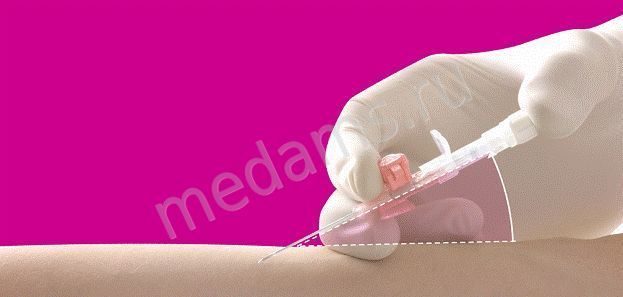
Special “wings” of the peripheral venous catheter allow you to securely fix the catheter on the patient’s skin, thereby significantly reducing the risk of mechanical damage to the inner wall of the vessel and the development of mechanical phlebitis. The thin-walled design of the catheter tube allows for maximum infusion rates with a minimum catheter diameter. The peripheral intravenous catheter with an additional port has an injection port for bolus administration of medications and flushing of the catheter, which makes it possible to administer medications during the infusion process. Catheter wings allow secure fixation of the catheter and eliminate the possibility of unauthorized removal; The venous catheter case reliably protects the needle and catheter from damage. The radiopaque tubing of the venous catheter provides an additional degree of safety by allowing monitoring of the distal tip of the catheter in the event of damage. The venous catheter is internationally color coded for the size of the catheter.
Caring for the patient after the central catheter insertion procedure
Hospital care
After the procedure, staff may provide the following assistance to aid recovery:
- An x-ray is taken to ensure that the catheter is in the correct position;
- The catheter insertion site is periodically checked for bleeding;
- Medicines, fluids, or nutritional solution are given through the catheter;
- The port catheter is flushed to prevent blood clots;
- Steps are taken to reduce the risk of infection: Wash your hands and gloves thoroughly before touching the catheter or changing the dressing;
- An antiseptic is used to clean the exposed parts of the catheter;
- Precautions are taken when handling medications, fluids, or foods that will be administered through the catheter;
- The patient is monitored for signs of infection, which include fever, chills, and problems at the insertion site (eg, redness, swelling, drainage);
- Visitors should not be in the hospital room when the dressing is changed;
- The catheter remains at the insertion site as long as necessary.
There are also steps you can take to reduce your risk of infection:
- Employees should be asked to take all precautions to prevent infection;
- Personnel should immediately alert the physician if there is redness or pain at the catheter insertion site;
- You must wash your hands before entering the room. Visitors should not be allowed to touch the catheter.
Home care
When you return home, you should do the following to ensure a normal recovery:
- The insertion site should be kept clean, dry and bandaged. When changing the dressing, follow the doctor's instructions;
- You should wash your hands or use hand sanitizer before touching the catheter;
- You should ask your doctor about when it is safe to shower, swim, or expose the surgical site to water;
- Do not swim or bathe with a central catheter inserted;
- Any activity that could weaken the central catheter should be avoided;
- No one should touch the catheter;
- The injection site should be checked every day for signs of infection (eg, redness, pain);
- The catheter should be flushed with saline or heparin as directed by your doctor.
Placement, replacement and care of a Foley catheter.
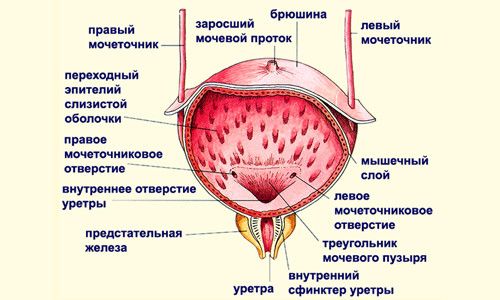
Structure of the bladder
Placement of a Foley catheter.
Before inserting a catheter, hygiene procedures must be carried out.
The specialist must wash the patient’s hands and perineum with soap, disinfect with an antiseptic and wear sterile gloves. Prepare the catheter (take it with sterile tweezers, treat it with lubricant if necessary).
Catheter insertion procedure for women:
Lying on your back, bend and spread your legs.
Having parted the labia and found the opening of the urethra, carefully insert the catheter. As soon as urine flows through the catheter, you should stop.
After this, through one of the passages at the outer end of the catheter, inject sterile water with a syringe in a volume sufficient to inflate the balloon. Then attach a urine collection bag to the outer end. It is necessary to ensure that the bag is always below waist level to avoid urine backflow through the catheter.
Catheter insertion procedure for men:
In men, catheter placement is more difficult. Since the urinary canal is longer and has physiological narrowings. The patient needs to lie on his back and slightly bend his knees, relax, the catheter is inserted into the urethra slowly and smoothly, with rotational movements, squeezing the catheter with the 5th and 4th fingers of the right hand, and first the genital organ must be held vertically, and then tilted down. Advance the catheter carefully. The presence of urine indicates that the catheter is inserted correctly.
For children:
When placing a catheter, it is necessary to ensure psychological comfort for the child.
Disinfect the genital areas twice and wrap them with a sterile cloth. Lubricate the end of the catheter with, for example, Vaseline.
Do not forcefully insert the catheter if an obstruction is felt - this can damage the urethra.
The procedure for inserting a catheter is similar to that for adults, but the depth of insertion is less because the urethra is shorter.
Urinary catheter care:
Wash the area around the catheter with soap and water several times a day to help avoid irritating infection. Be sure to do this after every bowel movement. Women are washed from front to back.
Drain the urine bag in a timely manner, keeping it below the level of the bladder to prevent urine from flowing back into the catheter.
Catheter replacement:
If urine outflow is normal, the catheter is replaced as planned according to the doctor’s recommendation and instructions for use of the catheter.
Silicone ones have a shelf life of up to 30 days, latex ones up to 7 days, silicone with silver up to 90 days.
Never pull on the catheter. Disconnect the catheter only to flush or replace it, or to empty the urine bag.
Cases when you need to see a doctor:
- Abdominal pain, flakes and blood in the urine appear.
— Urine is leaking from under the catheter.
— The outflow of urine has ceased.
Reasons why urine may leak:
the catheter is too thin, the balloon is not inflated enough, the catheter or urinal tube is kinked, the catheter is blocked.
Reasons why urine stops coming out:
kinking of the catheter or urinal tube,
insufficient fluid intake into the body (increase the amount of fluid consumed),
the urine bag is fixed too high (lower it below the level of the bladder),
catheter blockade,
impaired renal function (anuria) as the patient’s condition worsens.
Urinary catheters are washed according to the doctor’s recommendation:
A warm saline solution is used for rinsing. If sediment or flakes appear in the urine, wash the catheter with a furatsilin solution, as well as miramistin or a chlorhexidine solution. For rinsing, use a Zhanne syringe.
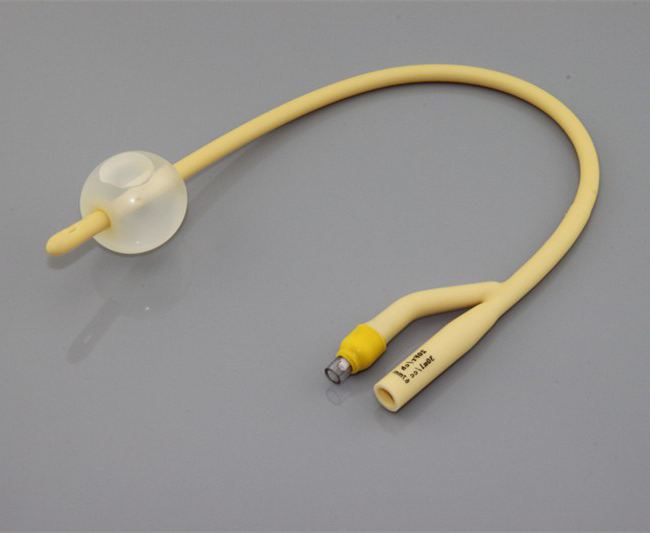
Foley catheter
Similar articles:
- Foley catheter: structure, materials, price, size
